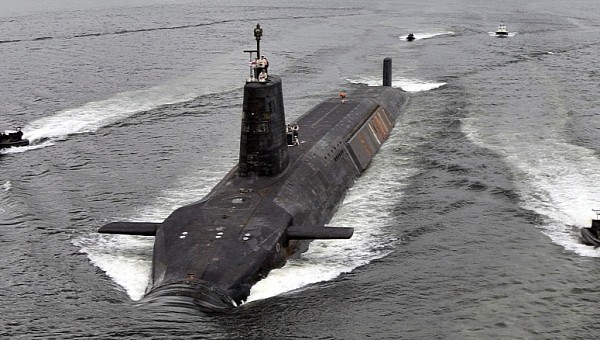There are times in life, you have no other choice but to cut a corner (or several), to improvise, or go for a quick fix, at least until a proper solution becomes available. This is not one of those times.
In what would be a hilarious story if it weren’t true, reports have emerged that broken bolts onboard a nuclear submarine were glued back on instead of replaced, and that the improper work was only discovered days before the nuclear reactor was about to be turned on at full power. Of all the times when a quick fix will do, one involving nuclear is not one.
The incident happened onboard HMS Vanguard, the flagship Vanguard-class submarine of the Royal Navy, which is equipped with the Trident ballistic missile system, the country’s deterrent. HMS Vanguard is the first of the four active Vanguard-class nuclear-powered ballistic missile submarines (SSBNs), was launched in March 1992 and is based in Scotland.
The botched repair work was discovered during a routine check at Devonport Dockyard in Plymouth, England, and is believed to have come courtesy of military contractor Babcock personnel.
News of the incident came via one of the tabloids, and while the UK Ministry of Defense (MoD) would not confirm the quick fix, they did confirm the existence of a “defect” that delayed the planned operation.
According to the report, it consisted of no less than seven bolts that held the thermal cladding in place on coolant pipes around the nuclear reactor, which broke when workers over-tightened them. Instead of replacing the broken bolts, workers resorted to sticking the heads back on with superglue. One of these broken heads fell off during the inspection.
The UK MoD is now conducting an investigation to determine who is responsible for what happened. Babcock tells the UK media that it’s conducting its own investigation into the incident, but maintains that it never posed any nuclear safety issues, even if it hadn’t been discovered.
“It’s a disgrace,” a Royal Navy source says, speaking of a breach of trust between the Royal Navy and the contractor. “You can’t cut corners with nuclear. Standards are standards. Nuclear standards are never compromised.”
The Vanguard submarines will be replaced in 2028 by the Dreadnought class, which will take over in carrying UK’s nuclear deterrent. All four units, HMS Vanguard, HMS Vengeance, HMS Victorious and HMS Vigilant, come with a total price tag of £15 billion ($18.4 billion), and an unlimited range that depends only on the amount of provisions onboard and maintenance work.
HMS Vanguard is 150 meters (492 feet) long and has a displacement of 15,900 tons, and can hit top speeds in excess of 25 knots (46 kph / 29 mph) when submerged. Glued-on bolts are not taken into account.
The incident happened onboard HMS Vanguard, the flagship Vanguard-class submarine of the Royal Navy, which is equipped with the Trident ballistic missile system, the country’s deterrent. HMS Vanguard is the first of the four active Vanguard-class nuclear-powered ballistic missile submarines (SSBNs), was launched in March 1992 and is based in Scotland.
The botched repair work was discovered during a routine check at Devonport Dockyard in Plymouth, England, and is believed to have come courtesy of military contractor Babcock personnel.
News of the incident came via one of the tabloids, and while the UK Ministry of Defense (MoD) would not confirm the quick fix, they did confirm the existence of a “defect” that delayed the planned operation.
According to the report, it consisted of no less than seven bolts that held the thermal cladding in place on coolant pipes around the nuclear reactor, which broke when workers over-tightened them. Instead of replacing the broken bolts, workers resorted to sticking the heads back on with superglue. One of these broken heads fell off during the inspection.
The UK MoD is now conducting an investigation to determine who is responsible for what happened. Babcock tells the UK media that it’s conducting its own investigation into the incident, but maintains that it never posed any nuclear safety issues, even if it hadn’t been discovered.
“It’s a disgrace,” a Royal Navy source says, speaking of a breach of trust between the Royal Navy and the contractor. “You can’t cut corners with nuclear. Standards are standards. Nuclear standards are never compromised.”
The Vanguard submarines will be replaced in 2028 by the Dreadnought class, which will take over in carrying UK’s nuclear deterrent. All four units, HMS Vanguard, HMS Vengeance, HMS Victorious and HMS Vigilant, come with a total price tag of £15 billion ($18.4 billion), and an unlimited range that depends only on the amount of provisions onboard and maintenance work.
HMS Vanguard is 150 meters (492 feet) long and has a displacement of 15,900 tons, and can hit top speeds in excess of 25 knots (46 kph / 29 mph) when submerged. Glued-on bolts are not taken into account.







